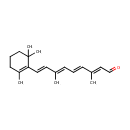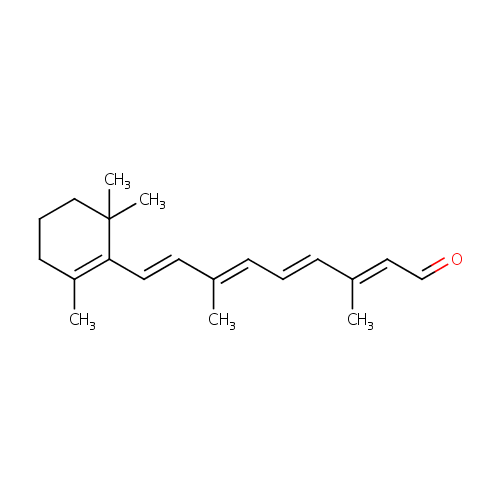|
Record Information |
|---|
| Version |
1.0 |
|---|
| Update Date |
1/22/2018 11:54:54 AM |
|---|
|
Metabolite ID | PAMDB002049 |
|---|
|
Identification |
|---|
| Name: |
Retinal |
|---|
| Description: | A carotenoid constituent of visual pigments. It is the oxidized form of retinol which functions as the active component of the visual cycle. It is bound to the protein opsin forming the complex rhodopsin. When stimulated by visible light, the retinal component of the rhodopsin complex undergoes isomerization at the 11-position of the double bond to the cis-form; this is reversed in 'dark' reactions to return to the native trans-configuration.; Retinal, also called retinaldehyde or vitamin A aldehyde, is one of the many forms of vitamin A (the number of which varies from species to species). Retinal is a polyene chromophore, and bound to proteins called opsins, is the chemical basis of animal vision. Bound to proteins called type 1 rhodopsins, retinal allows certain microorganisms to convert light into metabolic energy.; The visual cycle is a circular enzymatic pathway, which is the front-end of phototransduction. It regenerates 11-cis-retinal.; Vertebrate animals ingest retinal directly from meat, or produce retinal from one of four carotenoids (beta-carotene, alpha-carotene, gamma-carotene, and beta-cryptoxanthin), which they must obtain from plants or other photosynthetic organisms (no other carotenoids can be converted by animals to retinal, and some carnivores cannot convert any carotenoids at all). The other main forms of vitamin A, retinol, and a partially active form retinoic acid, may both be produced from retinal.; catalyzed by retinal dehydrogenases also known as retinaldehyde dehydrogenases (RALDHs) as well as retinal oxidases. Retinoic acid, sometimes called vitamin A acid, is an important signaling molecule and hormone in vertebrate animals. |
|---|
|
Structure |
|
|---|
| Synonyms: | - &alpha
- (2E,4E,6E,8E)-3,7-dimethyl-9-(2,6,6-trimethylcyclohex-1-en-1-yl)nona-2,4,6,8-tetraenal
- -Retinene
- 3,7-dimethyl-9-(2,6,6-trimethyl-1-cyclohexen-1-yl)-2,4,6,8-Nonatetraenal
- a-Retinene
- All-E-Retinal
- All-epsilon-Retinal
- All-trans-Retinal
- All-trans-Retinaldehyde
- All-trans-retinene
- All-trans-vitamin a aldehyde
- Alpha-Retinene
- Axerophthal
- E-Retinal
- Epsilon-Retinal
- Retinal
- Retinal (ACD/Name 4.0)
- Retinaldehyde
- Retinene
- Retinene 1
- Trans-Retinal
- Trans-Vitamin A aldehyde
- Vitamin a aldehyde
- Vitamin A1 aldehyde
- α-Retinene
|
|---|
|
Chemical Formula: |
C20H28O |
|---|
| Average Molecular Weight: |
284.4357 |
|---|
| Monoisotopic Molecular
Weight: |
284.214015518 |
|---|
| InChI Key: |
NCYCYZXNIZJOKI-OVSJKPMPSA-N |
|---|
| InChI: | InChI=1S/C20H28O/c1-16(8-6-9-17(2)13-15-21)11-12-19-18(3)10-7-14-20(19,4)5/h6,8-9,11-13,15H,7,10,14H2,1-5H3/b9-6+,12-11+,16-8+,17-13+ |
|---|
| CAS
number: |
116-31-4 |
|---|
| IUPAC Name: | (2E,4E,6E,8E)-3,7-dimethyl-9-(2,6,6-trimethylcyclohex-1-en-1-yl)nona-2,4,6,8-tetraenal |
|---|
|
Traditional IUPAC Name: |
retinaldehyde |
|---|
| SMILES: | C\C(\C=C\C=C(/C)\C=C\C1=C(C)CCCC1(C)C)=C/C=O |
|---|
|
Chemical Taxonomy |
|---|
|
Taxonomy Description | This compound belongs to the class of organic compounds known as retinoids. These are oxygenated derivatives of 3,7-dimethyl-1-(2,6,6-trimethylcyclohex-1-enyl)nona-1,3,5,7-tetraene and derivatives thereof. |
|---|
|
Kingdom |
Organic compounds |
|---|
| Super Class | Lipids and lipid-like molecules |
|---|
|
Class |
Prenol lipids |
|---|
| Sub Class | Retinoids |
|---|
|
Direct Parent |
Retinoids |
|---|
| Alternative Parents |
|
|---|
| Substituents |
- Retinoid skeleton
- Diterpenoid
- Enal
- Alpha,beta-unsaturated aldehyde
- Hydrocarbon derivative
- Organooxygen compound
- Carbonyl group
- Aldehyde
- Aliphatic homomonocyclic compound
|
|---|
| Molecular Framework |
Aliphatic homomonocyclic compounds |
|---|
| External Descriptors |
|
|---|
|
Physical Properties |
|---|
| State: |
Solid |
|---|
| Charge: | 0 |
|---|
|
Melting point: |
63 °C |
|---|
| Experimental Properties: |
|
|---|
| Predicted Properties |
|
|---|
|
Biological Properties |
|---|
| Cellular Locations: |
Membrane |
|---|
| Reactions: | |
|---|
|
Pathways: |
Not Available |
|---|
|
Spectra |
|---|
| Spectra: |
|
|---|
|
References |
|---|
| References: |
- Aarli JA, Mork SJ, Myrseth E, Larsen JL: Glioblastoma associated with multiple sclerosis: coincidence or induction? Eur Neurol. 1989;29(6):312-6. Pubmed: 2691257
- Bradbury MW, Lightman SL: The blood-brain interface. Eye. 1990;4 ( Pt 2):249-54. Pubmed: 2199234
- Bringmann A, Reichenbach A, Wiedemann P: Pathomechanisms of cystoid macular edema. Ophthalmic Res. 2004 Sep-Oct;36(5):241-9. Pubmed: 15583429
- Chang M, Herbert WN: Retinal arteriolar occlusions following amniotic fluid embolism. Ophthalmology. 1984 Dec;91(12):1634-7. Pubmed: 6521996
- Fukushima A, Ueno H, Fujimoto S: Antigenic cross-reactivity between human T lymphotropic virus type I (HTLV-I) and retinal antigens recognized by T cells. Clin Exp Immunol. 1994 Mar;95(3):459-64. Pubmed: 8137541
- Jankowska R, Witkowska D, Porebska I, Kuropatwa M, Kurowska E, Gorczyca WA: Serum antibodies to retinal antigens in lung cancer and sarcoidosis. Pathobiology. 2004;71(6):323-8. Pubmed: 15627843
- Nguyen QD, Van Do D, Feke GT, Demirjian ZN, Lashkari K: Heparin-induced antiheparin-platelet antibody associated with retinal venous thrombosis. Ophthalmology. 2003 Mar;110(3):600-3. Pubmed: 12623829
- Ramirez JM, Ramirez AI, Salazar JJ, de Hoz R, Trivino A: Changes of astrocytes in retinal ageing and age-related macular degeneration. Exp Eye Res. 2001 Nov;73(5):601-15. Pubmed: 11747361
- Weiland JD, Liu W, Humayun MS: Retinal prosthesis. Annu Rev Biomed Eng. 2005;7:361-401. Pubmed: 16004575
- Wu WC, Lai CC, Liu JH, Singh T, Li LM, Peumans WJ, Van Damme EJ, Wu AM: Differential Binding to Glycotopes Among the Layers of Three Mammalian Retinal Neurons by Man-Containing N-linked Glycan, T(alpha) (Galbeta1-3GalNAcalpha1-), Tn (GalNAcalpha1-Ser/Thr) and I (beta)/II (beta) (Galbeta1-3/4GlcNAcbeta-) Reactive Lectins. Neurochem Res. 2006 May 23;. Pubmed: 16718528
- Wu WC, Lai CC, Liu JH, Singh T, Li LM, Peumans WJ, Van Damme EJ, Wu AM: Differential binding to glycotopes among the layers of three mammalian retinal neurons by man-containing N-linked glycan, T(alpha) (Galbeta1-3GalNAcalpha1-), Tn (GalNAcalpha1-Ser/Thr) and I (beta)/II (beta) (Galbeta1-3/4GlcNAcbeta-) reactive lectins. Neurochem Res. 2006 May;31(5):619-28. Epub 2006 May 23. Pubmed: 16770733
- Yamashiro K, Tsujikawa A, Ishida S, Usui T, Kaji Y, Honda Y, Ogura Y, Adamis AP: Platelets accumulate in the diabetic retinal vasculature following endothelial death and suppress blood-retinal barrier breakdown. Am J Pathol. 2003 Jul;163(1):253-9. Pubmed: 12819029
|
|---|
| Synthesis Reference: |
Duhamel, Lucette; Duhamel, Pierre; Lecouve, Jean Pierre. A new synthesis of retinals. Journal of Chemical Research, Synopses (1986), (1), 34-5. |
|---|
| Material Safety Data Sheet (MSDS) |
Download (PDF) |
|---|
|
Links |
|---|
| External Links: |
|
|---|


